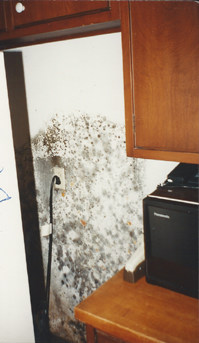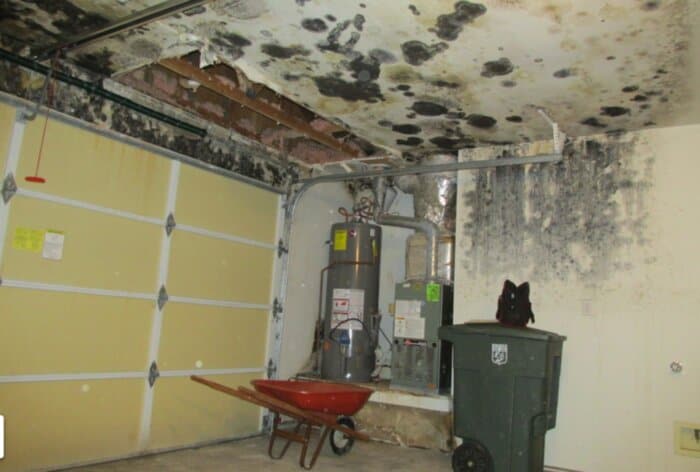Whether you’re a homeowner, a property manager, or a realtor, discovering mold in a house is incredibly frustrating! How did it get there? How can you get rid of it How can you keep it from happening again? What causes mold in a house anyway? These are some of the questions you’re probably asking. With our decades of experience as professional mold removers, we here at Cleaner Guys are here to tell you the top 15 causes of mold in a house, and how to prevent them. Read on!
Table of Contents
- What is Mold?
- What Causes Mold in a House?
- Top 15 Most Common Causes of Mold in a House
- How Do You Stop Mold from Growing in Your House?
- How Do You Get Rid of Mold in Your House That’s Already There?
- Frequently Asked Questions
What is Mold?
Mold is a fungus, an organism distinct from both plants and animals. It grows wherever it can find moisture, oxygen, and a food source it can absorb. This means that mold is most commonly found in areas with high levels of condensation or humidity, or anywhere there is water damage, like a leak or a flood.
Mold spores are floating around in the air all the time, indoors and outdoors, just like dust particles and bacteria. People don’t get sick from the spores usually floating around in the air because the concentration of spores is too low to cause a reaction in the body. However, wherever mold spores find excess moisture, like from a leak or condensation, they will land and begin to root and grow. Once mold starts rooting and growing on a surface, it begins releasing its own spores. This greatly increases the concentration of mold spores in the air, which is why people living near mold growth can get mold sickness.
What Causes Mold in a House?
Mold grows anywhere there is moisture, oxygen, food, and warmth. Only the first 3 are necessary, but mold tends to grow faster where there is warmth and humidity. The average well-maintained home or business does not have enough moisture present for mold to take root. That’s why mold almost always starts growing after some sort of water damage. As soon as there is excess moisture in an area, mold can take less than 48 hours to grow. The following are the top 15 sources of moisture that cause mold in a home, in our experience.
Top 15 Most Common Causes of Mold in a House
- Leaking roof. This is by far the most common source of mold in attics.
- Leaking or burst pipes inside the walls or in sink cupboards. Visit our guide on how to recognize water damage and mold inside walls, where you can’t see it.
- Poorly ventilated bathroom. Hot showers cause condensation and humidity, sources of moisture that mold can use to grow.
- Leaking refrigerator. The water supply line and ice maker can both break and cause leakage, which mold will latch onto.
- Leaking washing machine. Mold often starts from a leaking water supply line to a washing machine.
- Gutter ice dams. Gutters clogged with debris can cause stagnant water, and when the water freezes and expands, it can create ice dams that penetrate your roof, causing water damage in your attic, which leads to mold.
- Leaking foundation. Your foundation walls can crack, allowing water in, which invites mold.
- Flooding damage. Both natural flooding and accidental flooding, such as an overflowed toilet or sink, can cause mold if not cleaned up properly.
- Animal excrement in the attic or crawlspace. Rodent and bat excrement is organic material mold can feed on.
- HVAC condensation. Condensation can form in the ventilation shafts, allowing mold growth.
- High humidity. Living in a high-humidity area increases the chance of mold growth, due to the excess moisture.
- Leaking plumbing in the crawlspace. Mold often spreads furthest in crawlspaces because no one likes going in them, so plumbing could be leaking down there for a long time before being discovered.
- Malfunctioning water heater. A leaking or burst water heater pipe can cause mold growth.
- Irregular or inconsistent cleaning. Leaving dust and dirt behind large appliances and furniture that you never move can cause mold growth back there.
- Damp and dirty clothing and clutter. Items that haven’t been moved in a very long time can accumulate mold.

How Do You Stop Mold from Growing in Your House?
Now that you know all the most common things that can cause mold, how do you prevent them from happening? These are the steps we strongly recommend to avoid mold in the future.
- Keep Indoor Humidity Low. We agree with the CDC’s recommendation to keep your indoor humidity ideally lower than 50%. You can achieve this either with proper ventilation or a dehumidifier. Remember: mold needs moisture to grow, so don’t give it any!
- Take Care of Leaks Immediately. They won’t go away on their own. Treat every leak like it could cost you thousands of dollars of damage if you don’t fix it right away. Because it could.
- Check behind and under large appliances regularly. Behind and under refrigerators and washing machines is one of the most common places we have to clean up mold. Pull them out and check at least every couple of months.
- Clean your gutters at least once each quarter. Clogged gutters cause ice dams and stagnant water, which can penetrate your attic.
- Check your attic, crawlspace, and foundation walls at least once each quarter. Small animals or moisture can move in overnight, and you want to be on top of that. If you don’t want to check yourself, hire someone to. Don’t let it go undone.
- Ventilation, ventilation, ventilation! Try to have some kind of airflow in every room. Ceiling fans, freestanding fans, and even opening a window will do. Stagnant air encourages mold growth.
- Regular Cleaning. Mold feeds on organic materials like dust and crumbs. Cleaning all those away makes your home more inhospitable to mold.
How Do You Get Rid of Mold in Your House That’s Already There?
Unless the area of mold growth is extremely small, we strongly advise against attempting to remove mold yourself. If the mold covers less than a 1 square foot area, you may be able to clean it off yourself with vinegar or a fungicide. We strongly recommend against using bleach on mold.
If, however, the mold covers more than 1 square foot, the best course of action is to leave the removal to professionals. This is because however much mold you can see, there is usually a lot more inside and behind the material that you can’t see. Home remedies like vinegar cannot penetrate deeply enough to completely kill widespread mold like that.
Removing widespread mold usually requires safely removing and properly disposing of all mold-infested materials, and cleaning the area thoroughly with chemical solutions that will actually kill the mold. Most untrained laypeople cannot do these steps safely or thoroughly enough, because they don’t have the professional training and equipment of a professional mold removal expert.
Additionally, no one but a mold expert can determine whether the mold is an extremely toxic species, or a fairly harmless one. A layperson attempting to remove mold that they don’t know is extremely toxic can lead to terrible side effects and sickness.
Frequently Asked Questions
Staying in a house infested with mold is generally not advisable. While mold sickness may only cause minor health problems for some, it may cause severe and dangerous reactions in others. If you can’t leave your home for a week or more while the mold is being removed, at least have everyone in the house or apartment live and sleep in a room that’s not infested with mold. Close the door to the room(s) that have mold, and open a window if you can. This will increase ventilation and discourage increased mold growth until someone can remove it.
Most species of molds are allergenic, which means they can cause mold sickness, but are not very dangerous. However, there are a couple of species of mold that are extremely toxic. Read more about the most common of these species here.
Mold inside walls can absolutely make you sick. Some people can suffer severe allergic reactions to mold, while others may experience mild symptoms, or none at all. Learn about all the symptoms of mold sickness here.
If you find yourself in the unfortunate position of needing a professional mold removal company in Western Washington State, consider Cleaner Guys as a high-quality, well-trusted option. We’re proud to boast award-winning customer service, lower prices than others, and top-notch workmanship! Contact us today through the menu at the top of your screen.

Disclaimer: This article is for informational purposes only. No part of this article is medical or legal advice, and may not be used as such. For all serious medical matters, consult your doctor. For all serious legal matters, consult your legal advisor. This article contains Cleaner Guys’ experience and opinions only.


